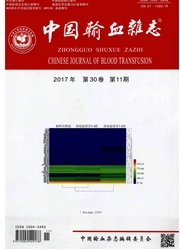

 中文摘要:
中文摘要:
目的探讨亚甲蓝光化学法(MB—P)灭活处理新鲜血浆后对1年保存期内部分凝血因子活性的影响。方法随机抽取30(人)份全血(400ml/份),按照标准操作规程将每份制备成新鲜血浆和病毒灭活新鲜血浆(100ml/份),分成未灭活组和灭活组,分别检测保存0(制备期〈1个月检测)、6、8、10、12个月后的2组各自的F1I:C、FV:C、FⅥ:C、FN:C、FIX:C、FX:C及Fg含量变化。结果与未灭活组相比,灭活组除FVII:C含量无明显变化外,其他6种凝血因子含量在保存期内均明显下降(尤其FⅧ:C和Fg下降最为明显);0、6、8、10、12个月保存时间的FⅧ:C含量(%)分别为灭活前58.7±20.1、59.6±34.0、52.0±35.3、57.5±34.7、54.1±31.2和灭活后45.8±13.9、49.3±23.5、44.6±21.7、49.7±22.9、43.9±20.7(均为P〈0.05),Fg含量(mgral)分别为灭活前225.3±72.3、277.9±64.2、272.3±74.9、262.6±70.8、287.55±83.0)和灭活后188.8±5,4.7、205.8±54.0、205.8±54.0、220.2±66.7、202.2±56.8(均为P〈0.05)。保存0和12个月相比,FX:C含量(%)分别为93.0±30.5体83.1±18.0(P〈0.05)。结论新鲜血浆经MB-P病毒灭活处理后,1年冰冻保存期内起7种凝血因子含量相对稳定;MB-P对凝血因子活性造成了一定损伤(尤其是Fg和FⅧ:C),但除FVⅢ:C外,其他凝血因子含量在可接受的范围内。
 英文摘要:
英文摘要:
Objective To investigate the effect of methylene blue photochemical method (MB-P)on the activities of cer- tain coagulation factors in virus inactivated fresh frozen plasma within one-year storage. Methods 30 batches of fresh plasma were randomly selected and each plasma was equally divided and subjected to MB-P treatment and non-treatment, constituting the virus inactivated group and non-inactivated group, respectively. The concentrations of coagulation factors F II : C ,F V : C ,F VH: C,FⅧ: C,FIX: C ,FX: C and Fg in plasma were determined at 0 ( less than one month) ,6,8,10 and 12 months after the preparation from the two groups. Results Compared with the non-inactivated group, except for the F VII : C ( P 〉 0. 05 ), the concentrations of the other 6 coagulation factors were significantly decreased in the virus inactivated group within one-year storage ,especially FⅧ: C and Fg. The concentrations of FⅧ: C( % ) and Fg(mg/dl) at month 0, 6, 8, 10 and 12 in non-in- activated group were 58.7 ± 20. 1, 59.6 ±34.0, 52. 0 ±35.3, 57.5 ±34.7, 54. 1± 31.2 and 225.3 ± 72.3, 277.9± 64. 2,272.3 ±74. 9,262. 6 ±70. 8,287. 55 - 83.0, while in virus inactivated group were 45. 8 ±13.9, 49. 3 ±23.5, 44. 6 ±21.7, 49.7 ±22.9, 43.9 ±20.7 and 188.8 ±54:7, 205.8 ±54.0, 205.8 ±54.0, 220.2 ±66.7, 202.2 ±56.8, respectively (P 〈 0. 05 ). By comparing the concentrations of coagulation factors at month 0 and 12,it was shown that only F X : C( % ) showed a significant decrease between month 0 and 12, with the concentrations of 93.0 ± 30. 5 and 83. 1 ± 18. 0 ,respectively ( P 〈 0, 05 ), while all the other coagulation factors were quite stable throughout the storage period. These results indicated that the lower eoncentrations of coagulation factors detected in the virus inactivated group are mostly due to the MB-P treatment before plasma freezing, while low temperature storage itself has no major impact on the stability of most eoagulation factors. Conclus
 同期刊论文项目
同期刊论文项目
 同项目期刊论文
同项目期刊论文
 期刊信息
期刊信息
